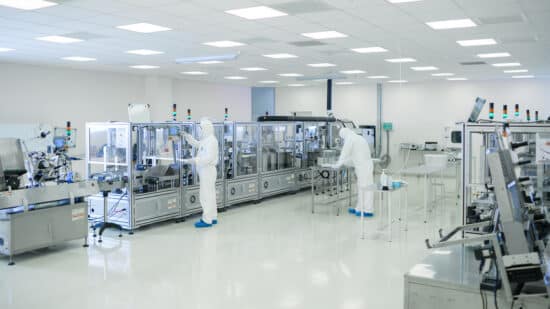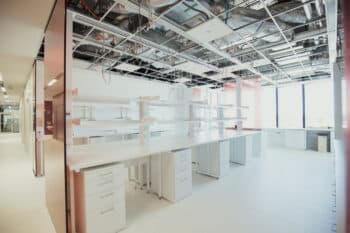
If your current laboratory suite is not fit for purpose, and is proving more of a hindrance than a help in your research, then it’s time for a full renovation. Whilst this can be a difficult process, particularly if the lab is continuously used, the long-term benefits are extensive.
In this article, we provide a quick guide to help you start planning a successful lab renovation, answering some of the key questions you may have from the offset.
Quick Navigation
- How do I budget for a lab renovation?
- Who needs to be involved in the decision-making process?
- How do I decide what elements and features I require?
- How do I pick a supplier?
- When should I review the process to determine the success of the project??
With the answers to the above questions, you should be able to start briefing out your requirements to suppliers and contractors, and start work on your blueprints.
How do I budget for a lab renovation?
This is a bit of a ‘how long is a piece of string?’ question – it stands to reason the more you invest, the more you’ll be able to achieve and the more revenue the lab could contribute. If your laboratory is partially or fully funded by grants, a better-developed suite could help attract more interest from investors.
The first step is to identify what you hope to achieve in the new laboratory, and discover the appetite for this kind of research in the grant community. Document all the opportunities for the types of research you’d like to pursue, and incorporate these into a budget plan – highlighting the investment opportunities and research gains. Submit this plan to investors, so they can see the full value of the research, and then request the highest budget possible.
Don’t be scared to negotiate at this point, the investors are likely to open with a conservative offer.

Who needs to be involved in the decision-making process?
There are a number of different people who are key to the decision-making progress when a new lab build is in the pipeline. Not only will a robust team help get final sign-off, but they will also help keep the project on course and ensure it meets its targets.
Naturally, the lab manager needs to be involved in the process and should be a driving force. A research lead should also be a part of the project, giving the greatest insight into the research they hope to conduct in the new surroundings and how it will help the whole business/organisation. It is highly likely that this person will be particularly passionate about the project, and this passion could help illuminate the benefits of investment and help it over the line.
From the outset, it is a good idea to find a stakeholder, board member or decisionmaker who is on your side and backs the project. Find a relevant person who you believe has the greatest passion for a project like this, and get them on-side. Not only will this advocate provide weight and legitimacy to your project, but they’ll also be able to provide steer. Understanding what the other decisionmakers are looking for in an investment, they can help you shape your proposal accordingly.
Finally, getting support from a senior member of the finance team can legitimise any budgeting claims you might make in the proposal and alleviate fears the board might have.
How do I decide what elements and features I need?
Unless you’re in the fortunate position of having unlimited funds to play with, you’ll have to make some decisions about what elements to include in your new lab and which to omit. Whilst there may be some features you’d love, they have to totally practical and beneficial to the operation.
Speak with your research teams and identify the elements they’d benefit from and the value they would provide. If you can place the elements in order of the number of projects they’d benefit, this will give you greater insight into your priority list.
There is also an argument to be made for a headline-grabbing piece of equipment or element. If your lab is the first in the region, country, continent (or even the world) to host a particular element, it could sway the board to commit the required funds. Whilst some members of the board will be considering the commercial benefits of the investment – some will get excited by the PR potential. If you’ve got a decisionmaker on your little lab build team – they’ll shed light on whether this tactic might be successful.

A laboratory renovation is a huge investment, so it is absolutely essential that you find a supplier and contractors that you totally trust. Build out a shortlist of suppliers capable of carrying out the refurbishment that you’re looking for – and then start to analyse their credentials.
It’s always a good idea to delve into any testimonials and case studies that the suppliers can provide, this will give you an insight into their quality of work and scale of projects they can handle. Furthermore, you could visit the sites of the case studies provided and review their work in person – so, you have total visibility of the project and not just the angles they want you to see.
NOTE – If a supplier can’t provide case studies, we’d recommend staying away.
It’s also a good idea to delve into the suppliers’ website, and look for the different services they provide. On our Laboratory refurbishment and fit-out page, we provide a succinct list of all the different services we offer.

When should I review the process to determine the success of the project?
When the last piece is fitted in the lab, the power and water are turned on and work commences, that is not the end of the renovation. It is essential that you review the lab’s impact over the next few months and years to identify whether it was a success.
When you built out the plan to secure funding in the opening stages of the process, you’ll have likely put together the potential funding the lab could attract and the new pieces of work the lab could support. Has the lab attracted new work? And has it supported new research? Review these and measure the impact against the investment, reporting your findings to stakeholders and board members.
Conducting reviews on the 18-month, three-year and five-year marks can shed light on the success of the project, and hopefully demonstrate your move was the correct one. If it can be proven that the laboratory renovation was a success, then you’ll be in a stronger position to secure additional funds for further projects in the future.
We hope that this guide has been helpful, and has given structure to the difficult process of planning a new laboratory build.
InterFocus can help you create an environment that’s the right fit for you and your team. For more information about our bespoke fitted labs, visit our homepage or call our team on 01223 894 833.




